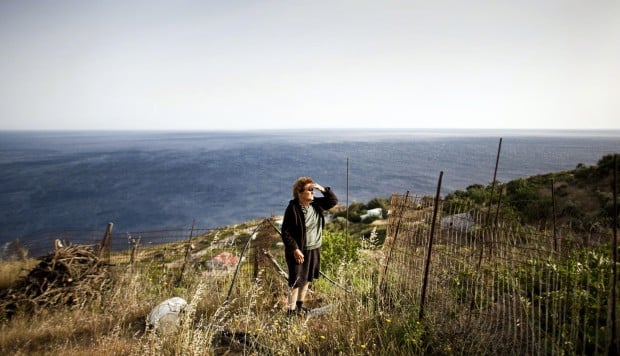The
inhabitants of one Greek island defy the laws of longevity, finds Andrew
Anthony, as he asks the locals to share their secrets
Young
Ionna Meli, just 80, looks out from the village of Nas across the "blue
zone" she calls home: Ikaria.
Gregoris
Tsahas has smoked a packet of cigarettes every day for 70 years. High
up in the hills of Ikaria, in his favourite cafe, he draws on what must
be around his half-millionth fag. I tell him smoking is bad for the
health and he gives me an indulgent smile, which suggests he's heard the
line before. He's 100 years old and, he says, aside from appendicitis,
he has not known a day of illness in his life.
Tsahas has short-cropped white hair, a robustly handsome face and a
bone-crushing handshake. He says he drinks two glasses of red wine a
day, but on closer interrogation he concedes that, like many other
drinkers, he has underestimated his consumption by a couple of glasses.
The secret of a good marriage, he says, is never to return drunk to your wife. He's been married for 60 years.
"I'd like another wife," he says. "Ideally one about 55."
Tsahas is known at the cafe as a bit of a gossip and a joker. He
comes here twice a day. It's a one-kilometre walk from his house over
uneven, sloping terrain. That's four hilly kilometres a day. Not many
people half his age manage that far elsewhere.
In Ikaria, a Greek island in the far east of the Mediterranean, about
50 kilometres from the Turkish coast, characters such as Tsahas are not
exceptional. With its beautiful coves, rocky cliffs, steep valleys and
broken canopy of scrub and olive groves, Ikaria looks similar to any
number of other Greek islands. But there is one vital difference: people
here live much longer than the population on other islands and on the
Greek mainland. In fact, people here live on average 10 years longer
than those in the rest of Europe and the United States - about one in
three Ikarians lives into their 90s. Not only that, but they also have
much lower rates of cancer and heart disease, suffer significantly less
depression and dementia, maintain a sex life into old age and remain
physically active well into their 90s. What is the secret of Ikaria?
What do its inhabitants know that the rest of us don't?
The island is named after Icarus, the young man in Greek
mythology who flew too close to the sun and, according to legend, fell
into the sea close to here. Thoughts of plunging into the sea are very
much in my mind as the propeller plane from Athens comes in to land.
There is a fierce wind blowing - the island is renowned for its wind -
and the aircraft appears to stall as it turns to make its final descent,
tipping this way and that until, at the last moment, the pilot takes
off upwards and decides to return to Athens. Nor are there any ferries,
owing to a strike.
"They're always on strike," an Athenian back at the airport says.
Stranded in Athens for the night, I discover that a fellow thwarted passenger is Dan Buettner, author of a book called
The Blue Zones,
which details the five small areas in the world where the populations
outlive the American and western European average by about a decade:
Okinawa in Japan, the Mediterranean island of Sardinia, the Nicoya
peninsula in Costa Rica, Loma Linda in the US state of California and
Ikaria.
Tall and athletic, 52-year-old Buettner, who used to be a
long-distance cyclist, looks a picture of well-preserved youth. He is a
fellow with
National Geographic magazine and became interested in
longevity while researching Okinawa's aged population. He says there
were several other passengers on the plane who are interested in
Ikaria's demographics.
"It would have been ironic, don't you think," he notes drily, "if a
group of people looking for the secret of longevity crashed into the sea
and died."
Chatting to locals on the plane the following day, I learn that
several have relations who are centenarians. One woman says her aunt is
111. The problem for demographers with such claims is that they are
often difficult to stand up. Going back to Methuselah, history is
studded with exaggerations of age. In the last century, longevity became
yet another battleground in the cold war. The Soviet authorities let it
be known that people in the Caucasus were living deep into their
hundreds, but subsequent studies have shown these claims lacked
evidential foundation.
Since then, various societies and populations have reported advanced ageing, but few are able to supply convincing proof.
"I don't believe Korea or China," Buettner says. "I don't believe the
Hunza Valley in Pakistan. None of those places has good birth
certificates."
However, Ikaria does. It has also been the subject of a number of
scientific studies. Aside from the demographic surveys that Buettner
helped organise, there was the University of Athens' Ikaria Study. One
of its members, Dr Christina Chrysohoou, a cardiologist at the
university's medical school, found the Ikarian diet featured a lot of
beans and not much meat or refined sugar. The locals also feast on
locally grown and wild greens, some of which contain 10 times more
antioxidants than are found in red wine, as well as potatoes and goat's
milk. Chrysohoou thinks the food is distinct from that eaten on Greek
islands with lower life expectancy.
"Ikarians' diet may have some differences from other islands' diets,"
she says. "The Ikarians drink a lot of herb tea and small quantities of
coffee; daily calorie consumption is not high. Ikaria is still an
isolated island, without tourists, which means that, especially in the
villages in the north, where the highest longevity rates have been
recorded, life is largely unaffected by the westernised way of living."
But she also refers to research that suggests the Ikarian habit of
taking afternoon naps may help extend life. One extensive study of Greek
adults showed that regular napping reduced the risk of heart disease by
almost 40 per cent. What's more, Chrysohoou's preliminary studies
revealed that 80 per cent of Ikarian males between the ages of 65 and
100 were still having sex. And, of those, a quarter did so with "good
duration" and "achievement".
"We found that most males between 65 and 88 reported sexual activity, but after the age of 90, very few continued to have sex."
In a small village called Nas, at the western end of Ikaria's north
shore, is Thea's Inn, a bustling guesthouse run by Thea Parikos, an
American-Ikarian who returned to her roots and married a local. Ever
since Buettner set up with his research team here a few years back,
Thea's Inn has been a base camp of sorts for anyone looking to study the
island's older population.
It's a good introduction to Ikarian life, if only because the dining
table always seems to bear a jug of home-made red wine and dishes made
from garden-grown vegetables. Whatever household we enter over the next
four days, even at the shortest notice, invariably confers the same
appetising hospitality. Yet Ikarians are far from wealthy. The island
has not escaped the Greek economic crisis and about 40 per cent of its
inhabitants are unemployed. Nearly everyone grows their own food and
many produce their own wine.
There is also a strong tradition of solidarity among Ikarians. During
the second world war, when the island was occupied by the Italians and
Germans, there was substantial loss of life through starvation - some
estimates put the death toll at 20 per cent of the population. It has
been speculated that one of the reasons for Ikarians' longevity is the
Darwinian effect of survival of the fittest.
 Vangelis Koutis, 97, who left Ikaria at 14 and returned to the island when he was 70.
Vangelis Koutis, 97, who left Ikaria at 14 and returned to the island when he was 70.After
the war, thousands of communists and leftists were exiled to the
island, bringing an ideological underpinning to the Ikarians' instinct
to share. As one of the island's few doctors told Buettner, "It's not a
'me' place. It's an 'us' place."
Nearly all elderly Ikarians have a story of suffering, though few are
keen to tell it. Kostas Sponsas lost a leg in Albania when he was blown
up by a German shell. He was saved by fellow Ikarians, without whose
help he would have died from loss of blood.
He recently turned 100 and is more mobile than many younger men with
two legs. Each day he pays a visit to the office of the shop he set up
decades ago.
"If I feel tired, I read," he says. "It rests my mind."
He was determined not to get depressed after losing his leg as a young man, instead remembering his grandfather's advice.
"He used to say to me, 'Be grateful that nothing worse has happened.'"
In terms of longevity, it was wise counsel. Depression, sadness,
loneliness, stress - they can and do take time off our lives. Sponsas'
own tips for a long life are that he never eats food fried with butter,
always sleeps well and with the window open, avoids eating too much
meat, drinks herb tea - mint or sage - and makes sure to have a couple
of glasses of red wine with his food.
Sponsas' son, a large middle-aged man with a broad smile, is with him
when I visit, fixing a broken door. Family is a vital part of Ikarian
culture and every old person I visit has children and grandchildren
actively involved in their lives.
Eleni Mazari, an estate agent on the island and a repository of local
knowledge, says, "We keep the old people with us. There is an old
people's home, but the only people there are those who have lost all
their family. It would shame us to put an old person in a home. That's
the reason for longevity."
Sponsas agrees: "To have your family around you makes you feel stronger and more secure."
Just a minute's walk from his house in the picturesque port of
Evdilos is the spotless home of Evangelia Karnava. In Ikaria, if you ask
people their age the answer they give is the year they were born.
Karnava, a tiny but formidable woman, was born in 1916. She radiates a
fierce energy, gesticulating like a politician on the stump. She lost
two baby girls to starvation during the war but she's not someone
haunted by tragedy. Instead, she speaks of her other three children,
seven grandchildren, four great-grandchildren and her
great-great-grandchild.
"I'm going to live to be 115," she says. "My grandmother was 107."
She certainly looks as if she's fit for a good few years yet. She
cleans her own flat and goes shopping every day. What's her secret? She
pours out glasses of Coca-Cola for her guests. "I can't live without
it!" she says.
Buettner appreciates the irony. He has been studying the diets of the
various blue zones he's visited for clues to a healthier lifestyle that
can be transported to post-industrial Western societies. Cigarettes and
Coca-Cola were not meant to be part of the programme.
The phrase "blue zone" was first coined by Buettner's colleague, the Belgian demographer Michel Poulain.
"He was drawing blue circles on a map in Sardinia and then referring
to the area inside the circle as the blue zone," Buettner says. "When we
started working together, I extended it to Okinawa, Costa Rica and
Ikaria. If you Google it now, it's entered the lexicon as a
demographically confirmed geographical area where people live measurably
longer."
So what does it take to qualify?
"It's a variation," Buettner says. "It's either the highest
centenarian rate, so the most centenarians per 1,000. Or it has the
highest life expectancy at middle age."
All the blue zones are slightly austere environments where life has
traditionally required hard work. But they also tend to be very social,
none more so than Ikaria. At the heart of the island's social scene is a
series of 24-hour festivals, known as
paniyiri, which all age
groups attend. They last through the night and the centrepieces are mass
dances in which everyone - teenagers, parents, the elderly, young
children - takes part. Sponsas says he no longer has the energy to go on
until dawn. He will now usually take his leave by 2am.
One evening, the island's star violin player, whom we first met at
Tsahas' favourite cafe, invites Buettner, me and several others back to
his house to hear him play. He says he often grows exhausted while
performing at festivals but that the energy and enthusiasm of the people
keep him going. He plays some traditional folk tunes, full of passion
and yearning and heart-rending beauty, and mentions with pride that
Mikis Theodorakis, the composer of
Zorba the Greek, was among the
leftists exiled on the island in the late 1940s. Theodorakis later
recalled the experience with pleasure. "How could this be?" he asked.
"The answer is simple: it's the beauty of the island in combination with
the warmth of the locals. They risked their lives to be generous to us,
something that helped us more than anything bear the burden of the
hardship."
One of the things Buettner has found that unites the elderly
inhabitants of all the blue zones is that they are unintentionally old:
they didn't set out to extend their lives.
"Longevity happened to these people," he says. "The centenarians
didn't all of a sudden at 40 say, 'I'm going to become 100; I'm going to
start getting exercise and eating these ingredients.' It ensues from
their surroundings. So my argument is that the environmental components
of places such as Ikaria are portable if you pay attention. And the
value proposition in the real world is maybe a decade more life
expectancy. It's not living to 100. But I think the real benefit is that
the same things that yield this healthy longevity also yield
happiness."
I ask a number of men in their 90s and 100s if they do any keep-fit
exercise. The answer is always the same: "Yes, digging the earth."
Nikos Fountoulis, for example, is a 93 year old who looks 20 years
younger. He still has a smallholding in the hills of the island's
interior. Each morning he goes out at 8am to feed his animals and tend
his garden. He used to dig charcoal as a younger man.
"I never thought about getting old," he says. "I feel good. I feel 93, but on Ikaria that's OK."
The island's greatest charm is that it is an unselfconscious place.
That could soon change: the spread of tourism is bound to have an
effect. Ikaria is protected by its remoteness and limited access but is
now at the mercy of blue-zone tourists, those relentless hordes of
blue-rinsed travellers looking for the elixir of eternal life. Buettner,
though, is doubtful his book will lead to planeloads of Floridian
retirees crowding the island.
"What are they going to do?" he asks. "They're not going to be able to descend upon the woman milking a goat."
On the day I leave Ikaria, I come across a man in a baseball cap
sitting in a chair outside his house in Evdilos. He is called Vangelis
Koutis and he's 97. He left the island when he was 14 to join the
merchant navy. He travelled all over the world and finally settled in
Canada. But, like a lot of Ikarians, he decided to return home in later
life, in his case when he was 70. I ask what brought him back.
"Fresh air," he says, "the best climate in the world and the friendliest people I've ever met."
With that, he returns to enjoying the sunshine on a beautiful spring
afternoon. It's hard to imagine many other places offering quite so
pleasant a time for a man in his 90s. Life in the blue zone is good. And
that may be the real secret of why it's also so long.

























 by Eddie Deezen
by Eddie Deezen Johnny Depp
is terrified of clowns. Says Johnny, "There's something about the
painted face, the fake smile. There always seems to be a darkness
lurking under the surface, a potential for real evil."
Johnny Depp
is terrified of clowns. Says Johnny, "There's something about the
painted face, the fake smile. There always seems to be a darkness
lurking under the surface, a potential for real evil." Yes, irony of ironies, Walt Disney, who gave the world Mickey Mouse, was indeed, afraid of mice.
Yes, irony of ironies, Walt Disney, who gave the world Mickey Mouse, was indeed, afraid of mice.  Woody Allen
was treated by psychoanalysts for 40 years (hmm, didn't seem to help
much). "I've been killing spiders since I was 30," says Allen about one
of his legion of fears and phobias. He is also deathly afraid of
showering in a shower where the drain is in the middle of the tub.
Woody's list of fears also includes stage fright, sunshine, children,
hotel bathrooms, cancer and other diseases, heights, crowds, and small
rooms. Woody also had claustrophobia and agorophobia.
Woody Allen
was treated by psychoanalysts for 40 years (hmm, didn't seem to help
much). "I've been killing spiders since I was 30," says Allen about one
of his legion of fears and phobias. He is also deathly afraid of
showering in a shower where the drain is in the middle of the tub.
Woody's list of fears also includes stage fright, sunshine, children,
hotel bathrooms, cancer and other diseases, heights, crowds, and small
rooms. Woody also had claustrophobia and agorophobia.  on is (ironically?) afraid of mirrors.
on is (ironically?) afraid of mirrors.